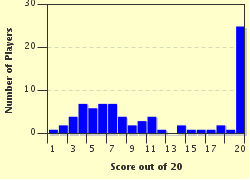Quiz Answer Key and Fun Facts
1. Hungarian is the largest Uralic language in number of speakers, and these speakers comprise nine major dialect continua. Eight of these dialects are relatively mutually-intelligible--that is, speakers of those eight dialects can understand each other with relative ease. The ninth dialect, however, is greatly divergent (different) from the others. What is the name of this dialect?
2. Which of the Saami languages has the greatest number of speakers?
3. Although the Saami languages are not a monolithic entity with variance only in pronunciation and lexicon, they share most of the same basic characteristics. They are closely related to Finnish, but have some major differences with standard Finnish. Which of these is a characteristic found in (most of) the Saami languages, but not in Finnish?
4. Which of the following is NOT a dialect continuum of Finnish?
5. Estonian is also closely related to Finnish, and it, too, has a "breakaway" dialect--one that has become a separate language of its own. What is the name of this language, which has vowel harmony that standard Estonian lacks?
6. A number of "small" Finnic languages are spoken in Russia, near Russia's borders with Finland and the Baltic states. Which of these is NOT one of them?
7. Moving ever eastward, we come to a group of languages traditionally referred to as the "Finno-Volgaic" branch of Uralic. This branch has a handful of less-known languages in it. One of them, formerly known as Cheremis, has two primary dialects: Hill and Meadow. What is the name of this language?
8. The other branch of Finno-Volgaic is occupied by a pair of languages once considered dialects of a single language; they are now thought to be closely-related (but not mutually-intelligible) languages. Erzya and Moksha are the two languages, but under what name were they previously lumped together?
9. Zyrian and Permyak are the two major dialect continua of which Uralic language, whose speakers are centered around the cities of Syktyvkar and Kudymkar?
10. The other major branch of the Permic group was a language once known as Votyak. What is the modern name for this language?
11. The Khanty and Mansi languages are Hungarian's closest relatives.
12. The Vakh dialect is divergent enough to be considered a separate language, but of which language is it still often considered a divergent dialect?
13. Which is the largest of the Samoyedic languages (both in terms of number of speakers and geographic area), with dialects divided into the highly-divergent Tundra and Forest varieties, and is the language from which the English word "parka" is ultimately derived?
14. The Sayan Mountain region has often been thought to be the birthplace of the Samoyedic peoples, who moved north and mingled with the early Uralic peoples. Those Samoyedic peoples who moved back into the region spoke now-extinct languages such as Kamass and Mator (the last-known speaker of Kamass died in 1989). Most of the Sayan Samoyedic people were assimilated by tribes from other groups, and most of these tribes spoke languages from one specific family. Which language family did most of the Sayan Samoyeds "convert" to?
15. And, finally, to Volochanka, which is a tiny community on Russia's Taimyr Peninsula. Volochanka is where you may have the best chance of hearing which Uralic language spoken? (It's the most-eastern of all of the extant Uralic languages.)
16. The remaining questions deal with overall characteristics of the Uralic languages.
Where is the Urheimat (original homeland) of the Uralic peoples believed to have been located?
17. Most of the Uralic languages are considered "vowel harmony" languages. What does vowel harmony entail?
18. The Uralic languages are predominantly of what type of language?
19. Basic word order in Uralic languages is either subject-verb-object or which other type?
20. In 2002, a group of "rogue" Uralicists came out with a book that made a surprising claim about Uralic. What was this claim?
Source: Author
Sapir
This quiz was reviewed by FunTrivia editor
LadyCaitriona before going online.
Any errors found in FunTrivia content are routinely corrected through our feedback system.

